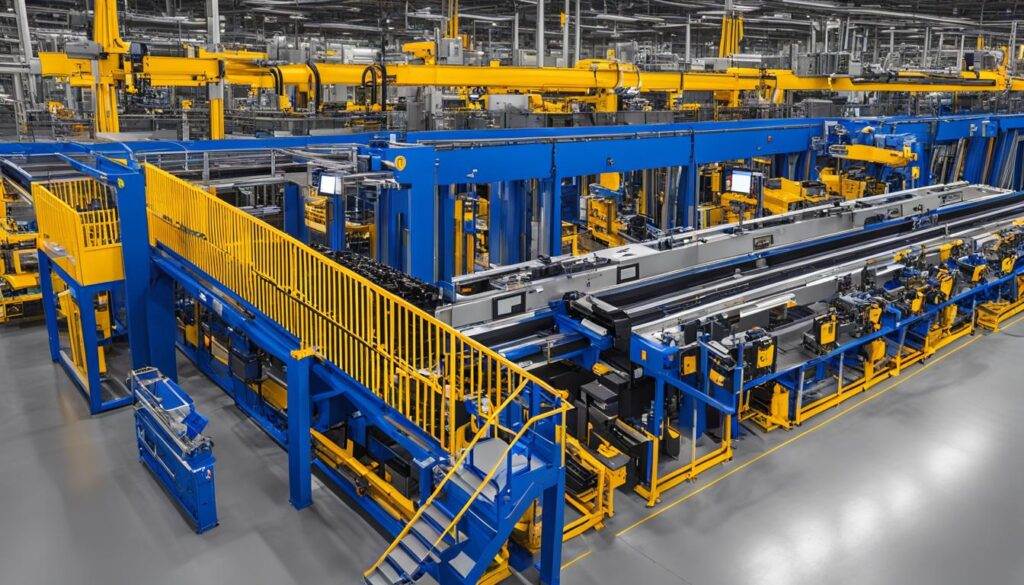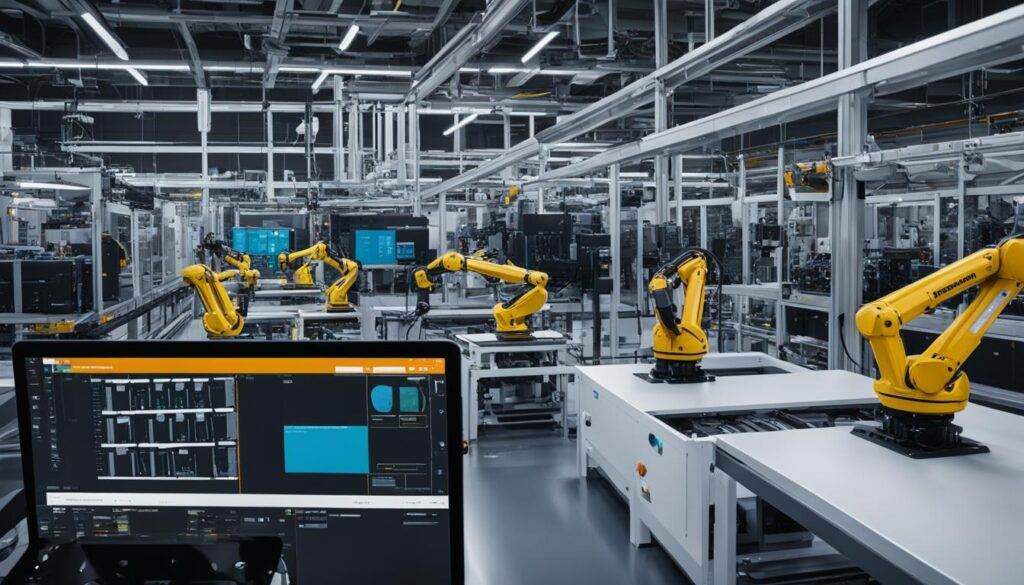Introduction
Manufacturing Information Systems (MIS) refer to a set of software solutions designed to collect, analyze, and present data related to the manufacturing process. These systems aim to optimize production, improve efficiency, and enhance decision-making.
Importance of Manufacturing Information Systems in modern manufacturing
In today’s competitive manufacturing landscape, MIS plays a vital role in enabling organizations to stay competitive and meet customer demands. Here are some reasons why MIS is important:
1. Real-time monitoring and control: MIS provides real-time visibility into the production process, allowing manufacturers to monitor key parameters, identify bottlenecks, and make timely adjustments to maximize productivity.
2. Data analysis and decision-making: By collecting and analyzing vast amounts of data, MIS helps manufacturers gain insights into production trends, quality issues, and resource utilization. This information enables informed decision-making and the implementation of process improvements.
3. Quality control and traceability: MIS facilitates quality control by tracking and recording key production parameters, ensuring compliance with standards and regulations. It also enables traceability, allowing manufacturers to quickly identify and address any quality issues or product recalls.
4. Inventory management and supply chain optimization: MIS helps manufacturers optimize inventory levels, minimize stockouts, and improve supply chain visibility. By providing accurate and timely data on stock levels, demand forecasts, and supplier performance, MIS enables better inventory planning and efficient procurement.
5. Integration and collaboration: MIS integrates with other enterprise systems such as ERP and CRM, enabling seamless data flow and collaboration across departments. This integration eliminates silos, improves communication, and streamlines processes, leading to increased efficiency and reduced costs.
Types of Manufacturing Information Systems
There are various types of MIS available, each catering to specific manufacturing needs. Here are some common types:
| Manufacturing Information System | Main Functions | Advantages | Disadvantages | Suitable for |
| Enterprise Resource Planning (ERP) | Integrates various business functions and processes | Streamlines operations and improves | High initial investment and | Medium to large-scale manufacturing organizations |
| such as finance, inventory, and customer relationship | decision-making | implementation costs | ||
| management | ||||
| Manufacturing Execution System | Tracks and controls production activities in real-time | Improves shop floor visibility and | Implementation complexities and | Small to large-scale manufacturing organizations |
| (MES) | productivity | customization challenges | ||
| Product Lifecycle Management | Manages product data and documentation throughout | Facilitates collaboration and | High implementation and | Manufacturing companies involved in product design and |
| (PLM) | its lifecycle | improves product development process | customization costs | development |
| Quality Management System | Manages quality processes and ensures compliance with | Improves product quality and | High implementation and | Manufacturing companies across industries |
| (QMS) | quality standards | regulatory requirements | customization costs | |
| Manufacturing Analytics | Analyzes manufacturing data to identify trends, | Enables data-driven decision-making | Requires skilled data analysts | Manufacturing organizations looking to optimize production |
| patterns, and potential improvements | and process optimization | and data interpretation skills | processes and efficiency |
It’s important to note that the suitability of these systems may vary depending on the specific needs and requirements of individual manufacturing organizations. It is advisable to evaluate different options and choose the one that aligns with your business goals and objectives.
OEE (Overall Equipment Effectiveness)
Meaning and significance of OEE in manufacturing
OEE, which stands for Overall Equipment Effectiveness, has long been considered a gold standard for measuring manufacturing productivity. It is a metric that assesses the performance of equipment in a production environment. OEE provides valuable insights into the efficiency and effectiveness of machines, helping manufacturers identify areas for improvement and optimize their operations.
How OEE helps in measuring and improving equipment performance
OEE measures the effectiveness of a machine by considering three key factors: availability, performance, and quality. By monitoring these factors, OEE provides a comprehensive view of how well a machine is performing and allows manufacturers to identify and address issues before they lead to downtime or suboptimal performance.
Here are the three components of OEE and how they contribute to measuring and improving equipment performance:
1. Availability: This component measures the percentage of time that a machine is available for production. It takes into account factors such as breakdowns, scheduled maintenance, and changeovers. By tracking machine availability, manufacturers can identify recurring issues or bottlenecks that affect productivity. This information can be used to implement preventive maintenance strategies or optimize production schedules to minimize downtime.
2. Performance: Performance refers to how efficiently a machine is running compared to its ideal capacity. It measures factors such as cycle time, speed losses, and equipment idling. By analyzing performance data, manufacturers can pinpoint areas where improvements can be made, such as optimizing machine settings, reducing cycle times, or addressing bottlenecks in the production process.
3. Quality: Quality measures the rate of production that meets the required specifications and standards. It takes into account factors such as rejects, rework, and defective products. By monitoring quality, manufacturers can identify root causes of product defects and implement corrective actions to improve product consistency and reduce waste.
Overall, OEE provides manufacturers with real-time insights into their equipment performance and helps them identify areas of improvement. By implementing strategies to address issues identified through OEE monitoring, manufacturers can increase productivity, reduce downtime, minimize waste, and ultimately enhance profitability and business growth.
In conclusion, OEE is a valuable tool for measuring and optimizing equipment performance in manufacturing. It provides manufacturers with a holistic view of their operations and helps them identify and address issues that can impact productivity and efficiency. By leveraging the insights provided by OEE, manufacturers can make data-driven decisions to improve their processes, reduce costs, and drive business growth.
MES (Manufacturing Execution System)
Overview of MES and its role in the manufacturing process
A Manufacturing Execution System (MES) is a software application that connects and manages the various components of a manufacturing operation. It collects and analyzes data related to machines, people, and production processes in real-time, providing manufacturers with valuable insights to optimize their operations and improve overall productivity.
The primary role of an MES is to track and document the transformation of raw materials into finished goods. It captures data on machine performance, production output, quality control, inventory management, and more. By integrating data from different processes and systems, MES enables manufacturers to have complete visibility and control over their operations, facilitating better decision-making and operational efficiency.
Key features and benefits of adopting MES in manufacturing operations
There are several key features and benefits of adopting an MES in manufacturing operations:
1. Real-time Monitoring and Control: MES provides real-time visibility into the entire production process, allowing manufacturers to track the status of machines, materials, and workers. This enables them to identify bottlenecks, issues, or anomalies immediately and take proactive measures to resolve them, improving overall efficiency and reducing downtime.
2. Data Collection and Analysis: MES collects and analyzes data from various sources, providing comprehensive insights into the performance of machines, operators, and production processes. This data-driven approach helps identify areas for improvement, such as reducing cycle times, optimizing machine settings, or implementing preventive maintenance strategies.
3. Quality Control and Compliance: MES includes modules for quality control, ensuring that products meet the required specifications and standards. It enables manufacturers to track and trace materials and processes, identify quality issues, and implement corrective actions promptly, reducing the risk of defects, recalls, and customer dissatisfaction.
4. Inventory Management: MES provides real-time visibility into inventory levels, enabling manufacturers to monitor stock levels, track materials, and optimize inventory levels. This helps reduce inventory costs, prevent stockouts, and ensure timely delivery of products to customers.
5. Integration with Enterprise Systems: MES integrates with other enterprise systems, such as Enterprise Resource Planning (ERP), Product Lifecycle Management (PLM), and Supply Chain Management (SCM) systems. This integration ensures seamless flow of information across the organization, enabling better coordination, faster decision-making, and improved collaboration.
6. Overall Equipment Effectiveness (OEE) Analysis: MES includes modules for measuring and analyzing OEE, a key performance metric that assesses the effectiveness of machinery. By monitoring factors such as availability, performance, and quality, manufacturers can identify areas for improvement and take proactive measures to optimize equipment performance and maximize efficiency.
In conclusion, adopting an MES in manufacturing operations offers a range of benefits, including real-time monitoring and control, data-driven decision-making, improved quality control, efficient inventory management, integration with enterprise systems, and OEE analysis. By leveraging these features, manufacturers can optimize their operations, improve productivity, reduce costs, and stay competitive in today’s dynamic manufacturing landscape.

Statistical Process Control
Introduction to Statistical Process Control and its relevance in manufacturing
Statistical Process Control (SPC) is a powerful method used in manufacturing to monitor and control production processes. It involves the use of statistical tools and techniques to measure and analyze data from the manufacturing process. SPC helps manufacturers ensure that their processes are operating within acceptable limits and produce products that meet the required quality standards.
How Statistical Process Control aids in maintaining product quality and reducing defects
SPC plays a crucial role in maintaining product quality and reducing defects in manufacturing. It helps manufacturers identify and eliminate process variations that can lead to defects and inconsistencies in the final product.
Here are some ways in which SPC aids in maintaining product quality and reducing defects:
- Early detection of process variations: SPC allows manufacturers to monitor key process parameters in real-time and detect any variations from the target values. By identifying these variations early, manufacturers can take corrective actions to bring the process back within control limits before any defects occur.
- Trend analysis and prediction: SPC enables manufacturers to analyze trends in process data and predict future performance. By understanding the patterns and trends in process variations, manufacturers can proactively make adjustments to the process to maintain product quality and prevent defects.
- Root cause analysis: When a defect or non-conformance occurs, SPC helps in identifying the root causes of the problem. It enables manufacturers to analyze process data and identify factors that contribute to the defect. By addressing the root causes, manufacturers can prevent the recurrence of similar defects in the future.
- Continuous improvement: SPC is a key component of continuous improvement initiatives in manufacturing. By regularly monitoring and analyzing process data, manufacturers can identify opportunities for process optimization and improvement. SPC provides the data-driven insights needed to make informed decisions and implement effective improvement strategies.
- Increased productivity and cost savings: By minimizing process variations and defects, SPC helps in improving overall process performance and productivity. It reduces the need for rework, scrap, and rejections, resulting in cost savings for the manufacturer. Moreover, improved product quality leads to higher customer satisfaction and loyalty, which can further drive business growth.
In conclusion, Statistical Process Control is a critical tool for maintaining product quality and reducing defects in manufacturing. It enables manufacturers to monitor and control their processes, detect process variations early, and take corrective actions to prevent defects. By leveraging the benefits of SPC, manufacturers can improve their overall process performance, reduce costs, and enhance customer satisfaction.
Selection Considerations for Manufacturing Data Systems
Factors to consider when choosing the right Manufacturing Information Systems
When selecting a manufacturing data system, there are several factors that should be taken into consideration. These factors will help ensure that the chosen system meets the specific needs and requirements of the manufacturing process. Here are some key considerations to keep in mind:
1. Scalability: It is important to choose a data system that can effectively handle the current manufacturing operations but also has the ability to scale as the business grows. This will ensure that the system can accommodate increased data volume and complexity without impacting performance.
2. Integration capabilities: The manufacturing data system should be able to seamlessly integrate with existing systems and equipment on the production line. This includes integration with PLCs, sensors, and other data sources to ensure a comprehensive and accurate data collection process.
3. Real-time monitoring: Real-time data monitoring is crucial for identifying and addressing any issues or deviations in the manufacturing process as they occur. The chosen data system should provide real-time alerts and notifications so that immediate action can be taken to prevent defects or quality issues.
4. Data analysis and reporting: The manufacturing data system should have robust data analysis capabilities, including the ability to generate comprehensive reports and visualizations. This will enable manufacturers to gain actionable insights from the collected data and make data-driven decisions for process improvement.
5. Customization options: It is important to choose a data system that can be customized to meet specific manufacturing requirements. This includes the ability to define custom metrics, dashboards, and reports that align with the specific performance indicators and goals of the manufacturing process.
6. Ease of use: The usability and user interface of the data system should be intuitive and user-friendly. This will ensure that operators and other stakeholders can easily navigate and utilize the system to access relevant data and insights.

Future Trends in Manufacturing Information Systems
Emerging technologies and their impact on Manufacturing Data Systems
As technology continues to evolve at a rapid pace, emerging technologies are set to have a significant impact on manufacturing data systems. These technologies can help companies further optimize their production processes and improve overall efficiency. Here are some of the emerging technologies that are likely to shape the future of manufacturing information systems:
1. Internet of Things (IoT): The IoT enables the connection of various devices and sensors in the manufacturing environment. This connectivity allows for real-time data collection and monitoring, enabling manufacturers to gain valuable insights and take immediate action when deviations occur. IoT integration with manufacturing data systems will provide a more comprehensive view of the production process, leading to improved decision-making and process optimization.
2. Artificial Intelligence (AI): AI algorithms can analyze vast amounts of manufacturing data and identify patterns and trends that humans may overlook. By leveraging AI, manufacturing data systems can automate data analysis, predict potential quality issues, optimize production schedules, and identify opportunities for improvement. AI-powered manufacturing data systems can lead to greater efficiency, reduced waste, and improved product quality.
3. Augmented Reality (AR): AR technology can overlay digital information onto the physical manufacturing environment, providing operators with real-time instructions, visualizations, and alerts. By integrating AR with manufacturing data systems, operators can have instant access to relevant data, such as process parameters, performance metrics, and maintenance instructions. This can enhance operational efficiency, reduce errors, and improve overall productivity.
4. Cloud Computing: Cloud-based manufacturing data systems allow for centralized data storage and processing, making it easier to access and analyze data from multiple locations. Cloud computing also enables real-time collaboration and data sharing across different teams and departments, facilitating faster decision-making and improving overall communication within the manufacturing organization.
In conclusion, the future of manufacturing information systems lies in the integration of emerging technologies such as IoT, AI, AR, and cloud computing. These technologies will enable manufacturers to collect and analyze vast amounts of data in real-time, make data-driven decisions, optimize production processes, and enhance overall operational efficiency. As these technologies continue to advance, manufacturing information systems will play a crucial role in driving innovation and improving the competitiveness of manufacturing organizations.
Conclusion
In conclusion, as technology continues to advance, manufacturing information systems are becoming increasingly important in driving innovation and improving the competitiveness of manufacturing organizations. The integration of emerging technologies such as IoT, AI, AR, and cloud computing will play a crucial role in shaping the future of manufacturing information systems.
Recap of different types of Manufacturing Information Systems
To recap, there are several different types of manufacturing information systems available, each with its own ideal use case and set of advantages. These include:
1. Manufacturing Execution Systems (MES): MES systems provide real-time operational intelligence, connecting shop floor activities with planning and management systems. They help track production progress, manage inventory, and optimize production schedules.
2. Enterprise Resource Planning (ERP) Systems: ERP systems integrate all aspects of a company’s operations, including manufacturing, finance, human resources, and supply chain. They streamline operations, improve collaboration, and provide a comprehensive view of the entire business.
3. Product Lifecycle Management (PLM) Systems: PLM systems help manage the entire lifecycle of a product, from conception and design to manufacturing and maintenance. They enable collaboration across different departments and improve product quality and time-to-market.
4. Quality Management Systems (QMS): QMS systems help ensure product quality by standardizing processes, performing inspections and audits, and managing non-conformances and corrective actions. They help improve product reliability, reduce defects, and enhance customer satisfaction.

Benefits and potential outcomes of adopting Manufacturing Data Systems
By adopting manufacturing data systems, organizations can benefit from several potential outcomes, including:
1. Improved operational efficiency: Manufacturing data systems enable real-time monitoring and analysis of production processes, allowing for quick identification and resolution of issues. This leads to improved efficiency, reduced downtime, and increased output.
2. Enhanced product quality: By collecting and analyzing large amounts of data, manufacturing data systems can identify trends and patterns that may indicate quality issues. This allows for early detection and prevention of defects, resulting in improved product quality.
3. Better decision-making: Manufacturing data systems provide real-time visibility into key performance indicators and production metrics. This enables informed decision-making based on accurate data, leading to more effective resource allocation and improved overall performance.
4. Streamlined collaboration and communication: Manufacturing data systems facilitate collaboration and communication across different teams and departments in the organization. Real-time data sharing, instant messaging, and virtual collaboration tools enable faster problem-solving, decision-making, and knowledge sharing.
In conclusion, adopting manufacturing data systems can significantly improve manufacturing operations by enhancing efficiency, quality, decision-making, and collaboration. With the continued advancement of technology, manufacturing organizations should embrace these systems to stay competitive and drive innovation in the industry.

